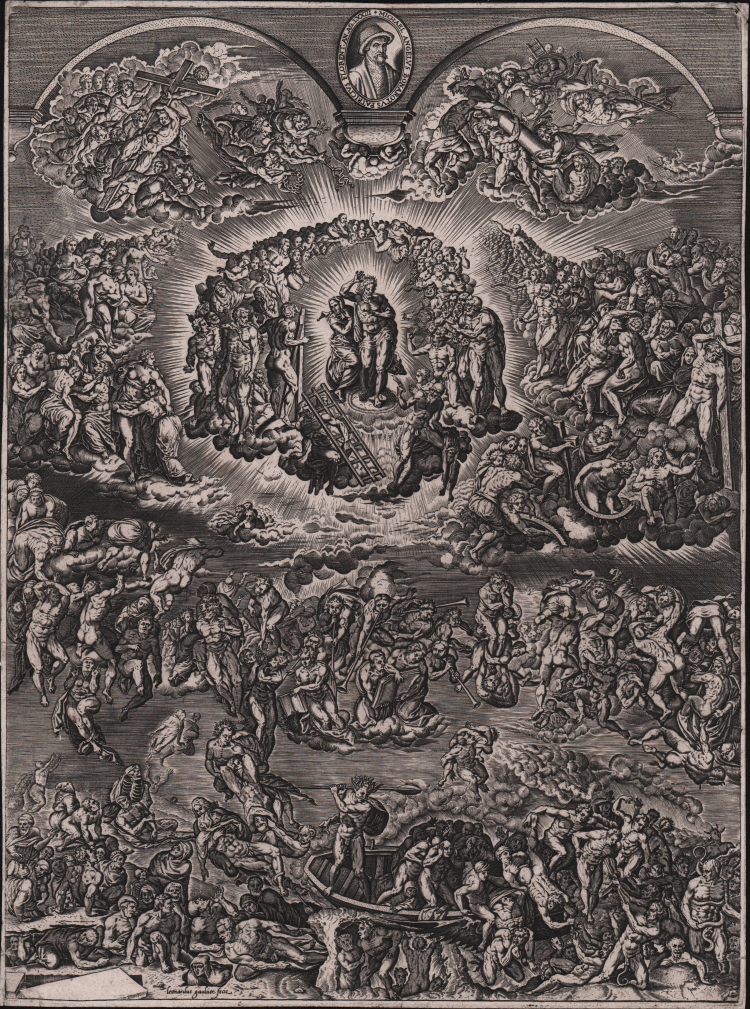




| Reference: | S44152 |
| Author | Léonard GAULTIER |
| Year: | 1600 ca. |
| Measures: | 230 x 310 mm |



| Reference: | S44152 |
| Author | Léonard GAULTIER |
| Year: | 1600 ca. |
| Measures: | 230 x 310 mm |
Engraving, circa 1600; in the oval around the portrait "MICHAEL ANGELVS BONAROTVS PATRICIVS FLORENT. AN. AG. LXXIII" lower left verso "leonardus gaultierfecit."
Printed translation of Michelangelo's famous fresco in the Sistine Chapel.
Example from the first state of three, before Pierre Mariette's address.
As Alessia Alberti points out, among the engravings that show Michelangelo's portrait at age 73 above, this may be the last one chronologically. The work probably pertains to Gaultier's already early seventeenth-century production. This group of works is united by other iconographic details such as the presence, in the lower left and foreground, of a tombstone slab, the fully hatched background, and the large cloud spread behind the figures in the right foreground. It follows that they could all be traced to a single prototype, either the Monogrammist CBS print or a common drawing source. In any case, the similarities remain striking, as already noted by Giovanni Agosti, with the miniature with this subject produced in the circle of Julius Clovius and now preserved in Casa Buonarroti.
Léonard Gaultier, born in 1561 in Mainz and died shortly after 1635 in Paris, was a French draughtsman, engraver and illustrator. Along with Thomas de Leu, he was one of the great printmakers of his time. Léonard was the son of Pierre Gaultier, a goldsmith merchant in Paris. He was a pupil of Étienne Delaune in Strasbourg, and subsequently worked mainly for publishers based in Lyon and Paris. Precocious, his first engravings date from 1576. For some of his large engravings, he drew inspiration from Antoine Caron, whose son-in-law he seems to have been. Above all, he developed the art of intaglio portraiture. He established himself in Paris in 1585 under the sign of Arche de Noé, rue du Monceau-Saint-Gervais, then, in 1599, like many print dealers, in rue Saint-Jacques, under the sign of Fleur du Lys d'or.
Magnificent proof, rich in tone, printed on contemporary laid paper, trimmed to the platemark, in excellent condition.
Collection signature on verso of Naudet with the date 1792 (Lugt no. 1937).
Bibliografia
IFF / Inventaire du Fonds Français: Bibliothèque Nationale, Département des Estampes (17); Alessia Alberti, d’Après Michelangelo, n. 192, I/III.
Léonard GAULTIER (Parigi, 1561circa -1635 circa)
|
Engraver and publisher. Son of Pierre Gaultier, a goldsmith merchant from Paris, he worked mainly in Lyon and Paris.
According to others he was originally from Mainz, perhaps a pupil of Etienne Delaune in Strasbourg. He collaborated with Thomas de Leu, probably his brother-in-law.
His style of work resembles that of Wierix and Crispin van de Passe. His prints are executed entirely by engraving, with great precision, but in a rigid and formal way. He was certainly very active and prolific, the Abbé de Marolles owned more than eight hundred prints of the Gaultier. Among his numerous works of text illustrator, the most important are the portraits (144) that decorate the collection Pourtraicts de plusieurs hommes illustres, qui ont flory en France depuis l'an 1500 jusques à présent and the engravings reproducing events under Henry IV. They are sometimes signed with his name, and sometimes with a cipher GL.
|
Léonard GAULTIER (Parigi, 1561circa -1635 circa)
|
Engraver and publisher. Son of Pierre Gaultier, a goldsmith merchant from Paris, he worked mainly in Lyon and Paris.
According to others he was originally from Mainz, perhaps a pupil of Etienne Delaune in Strasbourg. He collaborated with Thomas de Leu, probably his brother-in-law.
His style of work resembles that of Wierix and Crispin van de Passe. His prints are executed entirely by engraving, with great precision, but in a rigid and formal way. He was certainly very active and prolific, the Abbé de Marolles owned more than eight hundred prints of the Gaultier. Among his numerous works of text illustrator, the most important are the portraits (144) that decorate the collection Pourtraicts de plusieurs hommes illustres, qui ont flory en France depuis l'an 1500 jusques à présent and the engravings reproducing events under Henry IV. They are sometimes signed with his name, and sometimes with a cipher GL.
|